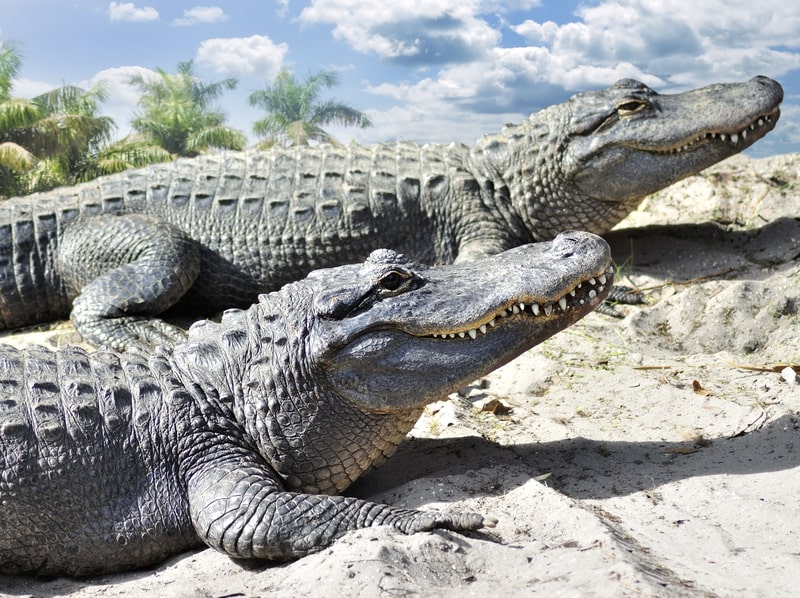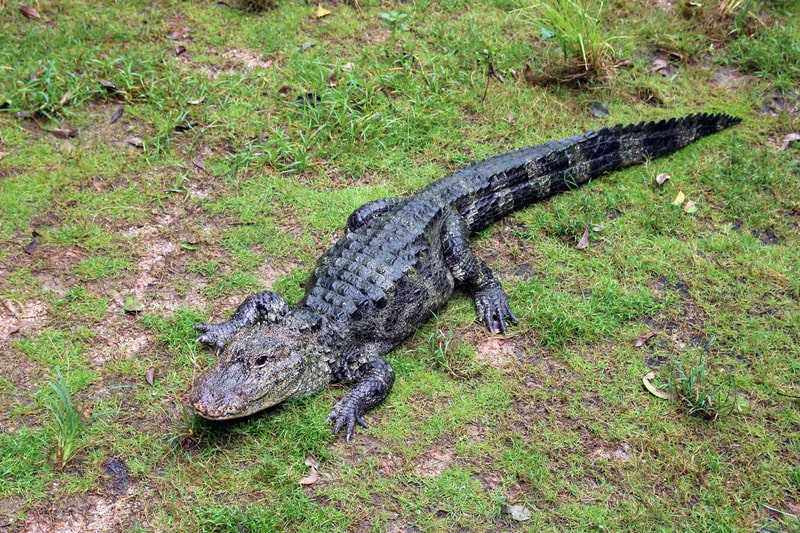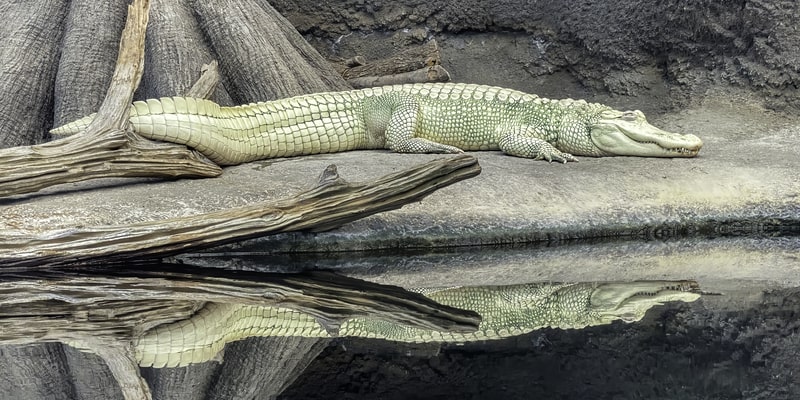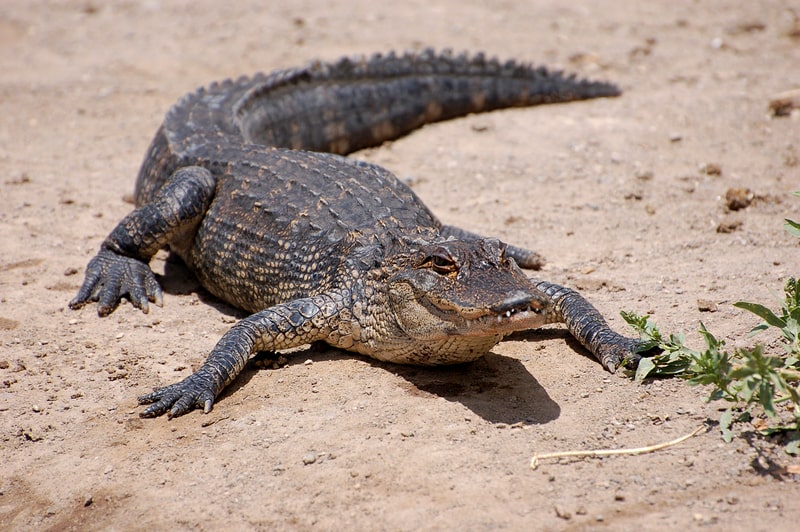Last updated on May 22nd, 2023
Alligators are living fossils. They walked with the dinosaurs and survived until the modern age, nearly unchanged. These highly adaptable animals coped with famines, ice ages, and other existential threats for millions of years. Most people fear them, but beneath the fierce exterior lies timid creatures. Those who appreciate their strength and abilities turned them into symbols. Individuals who understand their role in ecosystems rallied for their conservation. Would you like to know more about these robust reptiles? Are you confused about alligators and crocodiles?
50 interesting facts about alligators.
Alligators vs. Crocodiles
1. Almost Twins
It is not easy to tell them apart at first glance. Alligators and crocodiles are lizard-like reptiles with long snouts, short legs, powerful tails, and bony-plated backs. However, crocodiles tend to be the larger of the two.
2. Snout Shape
Try to zoom in to see the differences, starting with the shape of their snouts. In alligators, these are broad with a U-shaped outline. On the other hand, crocodiles have narrow, V-shaped snouts.
3. Teeth Visibility
Their reptilian teeth are sharp and scary. Fortunately, alligators keep their’s hidden when their mouths are closed. You cannot say the same for crocodiles. Some of their bottom teeth protrude, almost as a warning to stay away.
4. Body Color
Would you like to tell them apart from afar? Understandable. Just use your binoculars and check out the color of their skins. The gray and black reptiles are probably alligators, while the olive and tan behemoths are crocodiles.
5. Aggression
Crocodiles are more aggressive than alligators. Crocs assert their dominance, while gators avoid conflict by walking away. However, both are dangerous predators that may attack if provoked. Keep your distance!
6. Taxonomy
According to scientific classification, the two belong to the same order: Crocodilia. They shared a common ancestor but diverged 80 million years ago. However, they belong to different families: Alligatoridae for gators and Crocodylidae for crocs.
7. Sensory Organs
Both reptiles have integumentary sense organs or ISOs. They detect pressure changes in the water while catching prey. With gators, these are on the head and mouth. With crocs, nearly every scale has an ISO.
8. Limb Lengths
The differences go beyond external markers. After comparing their anatomies, scientists found that alligators have slightly shorter forelimbs and hindlimbs.

9. Habitat
It is all about salt tolerance. Crocodiles can effectively remove the excess mineral from their bodies, allowing them to live in salty seas, mangroves, and swamps. Alligators have ineffective salt glands, forcing them to stick to freshwater areas like lakes and marshes.
10. Global Distribution
Thanks to their supreme adaptability, crocodiles are scattered across a wider area around the world. You can find them in Asia, Africa, Australia, and the Americas. Meanwhile, alligators live in Eastern China, Mexico, and the Southeastern United States.
Alligator Basics
11. Etymology
Early European explorers in Florida called the reptile El Lagarto or The Lizard. English speakers later anglicized it into allagarta, alagarto, and alligator.
12. Evolution
Ancient crocodilians first appeared 200 million years ago. According to fossil records, some of them evolved into the American alligator about 84 million years ago during the time of the dinosaurs. They have not changed much since then.
13. Biped Ancestors
Did ancient alligators walk on two feet? The mud prints of Batrachopus Grandis have deep heel marks and no tail drag, suggesting a more upright posture. Scientists from the University of Colorado found the 120-million-year-old fossil tracks in South Korea.

14. Two Species
There used to be plenty of alligators roaming around. Scientists discovered at least eight variants. Now we only have two species left: the American alligator and the Chinese alligator.
15. Dimensions
Gators stay low, but they grow long. Adults may weigh up to 790 pounds and measure around 13 feet from snout to tail. The largest specimen was 19.2 feet from Louisiana. Louisiana also has the largest alligator population.
16. Average Lifespan
Gators are resilient reptiles. They can live for several decades no matter where they are. In the wild, they tend to last for about 50 years. In captivity, they can reach the ripe old age of 80.
17. Rapid Running
Alligators are super sprinters but dreadful distance runners. They can move at 35 mph on land, which is comparable to the speed of rabbits, giraffes, and red foxes. However, they quickly get tired because of their heavy weight and inefficient stride.

18. White Alligators
White gators are visible targets. It is hard for them to survive in the wild, so most living specimens are in captivity. Albino alligators have a congenital absence of melanin, while leucistic ones have an underlying condition causing partial loss of pigmentation.
19. A High-protein Diet
As you might expect, the alligator diet is heavy on meat. Young ones satisfy themselves with bugs, small fish, and amphibians. Adults turn to turtles, snakes, birds, mammals, and large fish.
20. Carb Consumption
Fierce carnivores? Not exclusively. Gators also munch on fruits and veggies when they find these. Scientists previously thought that the seeds retrieved from their tummies came from the prey they ate until witnesses saw them deliberately eating plants.
Interesting Traits and Behaviors
21. Teeth Replacement
Gators can lose their teeth during violent struggles with prey. They shrug it off since they can always grow more. You will only see around 75 teeth simultaneously, but they can go through over 3,000 in a lifetime.
22. Dormancy
These cold-blooded creatures cannot regulate their body temperature. They depend on their environment for protection from extreme weather, digging holes in the ground to hide away. They can survive inside for up to five months by slowing their metabolism and heart rate.
23. Blood as Medicine
Wild alligator blood is natural medicine. It can fight bacteria and viruses, helping the animal stay alive despite injuries and environmental changes. Researchers are studying its potential to cure the West Nile Virus, Herpes, and HIV-1.
24. Sleeping Underwater
Alligators can sleep on land or in water. When submerged, they can hold their breath for 20 minutes in warm water or hours in cold water. However, they typically sleep with their snouts above the surface to get air.

25. Submerged Stalkers
Gators are patient predators. They observe targets from afar, often hiding underwater with only their eyes peeking and lunging at just the right moment to catch unsuspecting prey. This strategy is particularly effective in the dark due to excellent night vision.
26. Evaporative Cooling
Do not panic if you see an alligator with an open mouth. Its sharp teeth look menacing, but it probably is not being aggressive. It is just cooling down by letting sweat evaporate through the mouth.
27. Bony Armor
Alligators have highly functional dermal bones. Aside from protecting their bodies from impact, these also neutralize acids in the bloodstream so they can stay for long periods underwater. The bones also supply calcium for eggshell formation.
28. Uni-directional Breathing
Mammals breathe in a bidirectional manner. Air flows into the lungs and goes out the same way. In alligators, air moves only one way in a circuit. It enters the outer branch of the lungs, goes around the parabronchi, and exits through the inner passages.
29. Uneven Strength
Different muscles control gator jaws. The ones in charge of closing them are strong, but those opening them are weak. Several layers of duct tape are usually enough to keep the mouth shut and manage risk during transport.
30. The Death Roll
Alligators consume small prey in one bite. As for large animals, they use a technique called death roll. They bite into the flesh and spin in the water to remove chunks of meat.
Alligator Life
31. Male or Female
Take out a thermometer! When it comes to alligators, the temperature of the egg nest determines sex. Warm nests above 34°C produce males, while nests below 30°C create females. In between? A mix of both sexes.
32. Inside the Eggs
It takes up to 65 days for the eggs to hatch, but you do not have to wait that long to know the sex of the offspring. Determination happens within 7 to 21 days of incubation.
33. Rotting Nests
Females build the nests. They gather vegetation from the immediate environment to provide a soft bed for their eggs. This organic matter generates heat as it decomposes to help in the incubation process.
34. Hatching
Mother gators watch over their eggs until they hatch. After all, these are vulnerable to hungry predators. Once the babies are ready to hatch, they emit a high-pitched call for their mom and break the shell with a tooth on their snout.
35. Best Moms
Female alligators are among the best reptile moms. Whereas others leave their babies in the wild, gators guide their young for up to two years until they are ready to roam independently.
36. Fierce Fathers
Females could mate with several males. Therefore, a single litter can have babies from multiple fathers. These dads may eat their young because of questionable paternity. Parents consume approximately 7% of babies.
37. Socialization
Large males tend to go solo. They spend their days defending prime territories. On the other hand, smaller alligators band together in “congregations.” They find strength in numbers, so they have a higher tolerance for others.

38. Locomotion
On land, gators typically walk high on four limbs. Before plunging, they drop to their belly and slither on the wet ground. They can also balance on their hind legs for brief periods, but they cannot walk using only these two limbs.
39. Loudest Reptiles
Gators get loud during the mating season. Males and females call out to attract partners, with some of them reaching 90 decibels. They are about as loud as the motor of your lawn mower. In contrast, most people can only shout up to 70 decibels.
40. Bellowing Choruses
Mating season occurs late in the spring. Just like roosters, male alligators may bellow together after sunrise. At night, they may also dance together in group courtship rituals.
Alligators and Humans

41. No Feeding Allowed
Do not feed wild gators in Florida. It can change alligator behavior as they associate humans with food. Instead of being timid, they may begin to approach people with disastrous consequences. Follow the state law!
42. Near Extinction
We almost lost the American alligator. Hunting for gator skin made their population dwindle in the 1900s, but conservation efforts helped them recover to over a million today. However, the Chinese alligator is still critically endangered. Only a few dozen mature individuals remain around the Yangtze River. Indeed, far more Chinese alligators live in zoos around the world than can be found in the wild.
. . . continue reading on the next page


